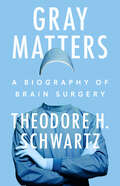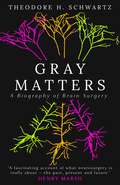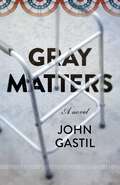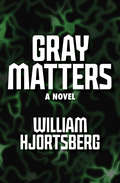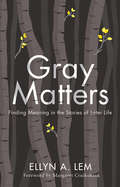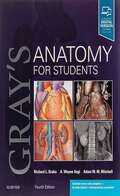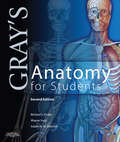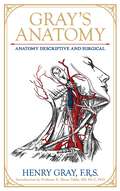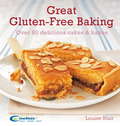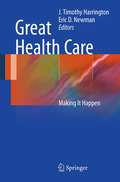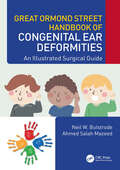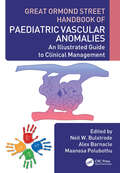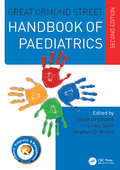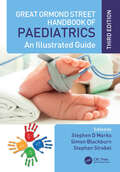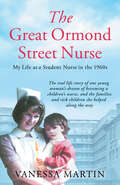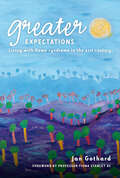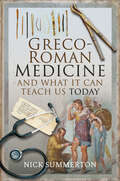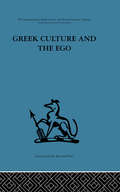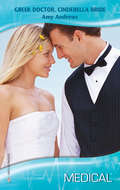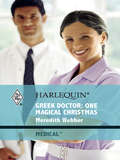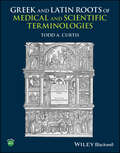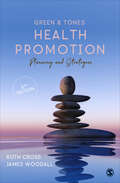- Table View
- List View
Gray Matters: A Biography of Brain Surgery
by Theodore H. Schwartz&“If you are at all curious about the brain or the surgeons who operate on it, Gray Matters is a must read and Dr. Theodore Schwartz is the perfect guide, a master brain surgeon and superbly talented writer. I have not read a better biography of our shared profession, and in Schwartz's talented hands, the most enigmatic 3 1/2 pounds of tissue in the known universe comes to light in remarkable and revelatory ways.&”—Dr. Sanjay Gupta, CNN Chief Medical Correspondent, and New York Times and #1 Wall Street Journal bestselling author of Keep Sharp: Build a Better Brain at Any AgeA popular biography of brain surgery, by one of its preeminent practitionersWe&’ve all heard the phrase &“it&’s not brain surgery.&” But what exactly is brain surgery? It&’s a profession that is barely a hundred years old and profoundly connects two human beings, but few know how it works, or its history. How did early neurosurgeons come to understand the human brain—an extraordinarily complex organ that controls everything we do, and yet at only three pounds is so fragile? And how did this incredibly challenging and lifesaving specialty emerge? In this warm, rigorous, and deeply insightful book, Dr. Theodore H. Schwartz explores what it&’s like to hold the scalpel, wield the drill, extract a tumor, fix a bullet hole, and remove a blood clot—when every second can mean life or death. Drawing from the author&’s own cases, plus media, sports, and government archives, this seminal work delves into all the brain-related topics that have long-consumed public curiosity, like what really happened to JFK, President Biden&’s brain surgery, and the NFL&’s management of CTE. Dr. Schwartz also surveys the field&’s latest incredible advances and discusses the philosophical questions of the unity of the self and the existence of free will. A neurosurgeon as well as a professor of neurosurgery at Weill Cornell Medicine, one of the busiest and most highly ranked neurosurgery centers in the world, Dr. Schwartz tells this story like no one else could. Told through anecdote and clear explanation, this is the ultimate cultural and scientific history of a literally mind-blowing human endeavor, one that cuts to the core of who we are.
Gray Matters: A Biography of Brain Surgery
by Theodore Schwartz&‘A fascinating and wide-ranging account of what neurosurgery is really about – the past, present and future.&’ Henry Marsh, author of Do No Harm Since its inception in the early twentieth century, brain surgery has maintained an air of mystery. As the saying &‘it&’s not exactly brain surgery&’ suggests, the specialty has become synonymous with a level of complexity and meticulousness rivalled only by, well, rocket science. Warm, rigorous and deeply insightful, neurosurgeon Theodore Schwartz reveals what it&’s really like to get inside someone&’s head – where every second can mean the difference between life or death. Drawing from Schwartz&’s experience in one of New York&’s busiest hospitals, Gray Matters explores the short but storied history of brain surgery. From the dark days of the lobotomy to the latest research into the long-term effects of contact sports on athletes&’ cerebral health, Schwartz unfolds the fascinating story of how we came to understand this extraordinary, three-pound organ, which not only keeps us alive, but makes us who we are.
Gray Matters: A Novel
by John Webster GastilCan the digital networks that record our footprints hold us steady when dementia threatens to push us off the path? This question has real stakes for data analyst Charlie Sanders. His best hope for a father succumbing to Alzheimer&’s comes from assistive technology that Charlie helps design for a scrappy startup. Despite early successes, Charlie has growing doubts about the motives of each of his colleagues - the eccentric CEO in Seattle, the call center guru in India, and the Trump-loving Aussie transplant who keeps the books. His worries grow when the company takes on a clandestine client who occupies the Oval Office. Will Charlie keep his father and his country on track, or turn a whole generation into glitches?
Gray Matters: A Novel
by William HjortsbergUnrest simmers in a dystopian future where disembodied brains are kept alive in tanks, waiting to earn a new body At twelve years old, Skeets Kalbfleischer is returning from a ski vacation when a lightning strike knocks his plane out of the sky, killing everyone else on board. Although his body is destroyed, a radical procedure preserves Skeets&’s brain, which spends twenty-five years in a fish tank before mankind realizes the implications of his second life. A key to immortality has been found. Four centuries later, it has become commonplace for the minds of the dead to be preserved. While warehoused in a massive storage facility tended by robots, the brains pass time watching old film clips, learning about bees, and meditating their way to a higher state of being. But for the facility&’s overseers, Skeets presents a problem. A twelve-year-old for all eternity, their most famous resident still wants to be a cowboy. To remedy this embarrassment, his handlers concoct a solution that will push humanity even farther past nature&’s wildest dreams. This ebook features an illustrated biography of William Hjortsberg including rare photos from the author&’s personal collection.
Gray Matters: Finding Meaning in the Stories of Later Life (Global Perspectives on Aging)
by Ellyn LemAging is one of the most compelling issues today, with record numbers of seniors over sixty-five worldwide. Gray Matters: Finding Meaning in the Stories of Later Life examines a diverse array of cultural works including films, literature, and even art that represent this time of life, often made by people who are seniors themselves. These works, focusing on important topics such as housing, memory loss, and intimacy, are analyzed in dialogue with recent research to explore how “stories” illuminate the dynamics of growing old by blending fact with imagination. Gray Matters also incorporates the life experiences of seniors gathered from over two hundred in-depth surveys with a range of questions on growing old, not often included in other age studies works. Combining cultural texts, gerontology research, and observations from older adults will give all readers a fuller picture of the struggles and pleasures of aging and avoids over-simplified representations of the process as all negative or positive.
Gray's Anatomy for Students
by Adam W. M. Mitchell A. Wayne Vogl Richard L. DrakeEasy to read, superbly illustrated, and clinically relevant, Gray’s Anatomy for Students, 4th Edition, is medical students’ go-to text for essential information in human anatomy. This fully revised volume focuses on the core information students need to know, in an easy-access format and with additional multimedia tools that facilitate effective study and mastery of the material. A team of expert authors and global advisors share their extensive teaching and clinical experience, highlighted by more than 1,000 innovative, original illustrations throughout the text.
Gray's Anatomy for Students
by Richard DrakeIt didn t take long for students around the world to realize that anatomy texts just don t get any better than Gray s Anatomy for Students. Only in its 2nd edition, this already popular, clinically focused reference has moved far ahead of the competition and is highly recommended by anyone who uses it. A team of authors with a wealth of diverse teaching and clinical experience has updated and revised this new edition to efficiently cover what you re learning in contemporary anatomy classes. An improved format, updated clinical material, and remarkable artwork by renowned illustrators Richard Tibbitts and Paul Richardson make anatomy easier than ever for you to master. Unique coverage of surface anatomy, correlative diagnostic images, and clinical case studies demonstrate practical applications of anatomical concepts. And, an international advisory board, comprised of more than 100 instructors, ensures that the material is accurate, up to date, and easy to use. Uses more than 1,000 innovative original illustrations- by renowned illustrators Richard Tibbitts and Paul Richardson-to capture anatomical features with unrivalled clarity, and makes body structures easy to locate and remember from one illustration to another through consistent use of color. Includes over 300 clinical photographs, including radiological images depicting surface anatomy and common clinical applications of anatomic knowledge. Presents an organization by body region that parallels the approach used in most of today s anatomy courses. Features conceptual overviews summarizing each body region's component parts, functions, and relationship to other bodily organs. Uses clinical cases to underscore the real-life relevance of the material. Features a rewritten abdomen section for greater clarity. Provides updates and revisions to clinical material to provide you with the absolute latest knowledge in the field. Includes expanded discussions of cranial nerves for added clinical relevancy. Uses a new internal design and presents an improved index for easier retrieval of information. Provides more information on the general aspects of anatomy via introduction chapter. "
Gray's Anatomy: Anatomy Descriptive and Surgical (Leather-bound Classics)
by Dr. Henry Gray FRSThis version of the original 1858 first edition of Gray&’s Anatomy is ideal for students and those with a keen interest in medicine.In 1858, Dr. Henry Gray published the first edition of what has become known as &“the doctor&’s Bible," with assistance from his colleague at St. George&’s Hospital in London, the anatomist and medical illustrator Henry Vandyke Carter. Their efforts led to the most famous reference book on human anatomy, which continues to be updated and revised today. This edition of Gray&’s Anatomy contains the original text and black-and-white illustrations from the first edition, providing valuable historical insights into the study and discussion of human anatomy. Also included are several key illustrations presented in full color. Dr. R. Shane Tubbs, Neurosurgery Professor and Anatomical Research Director at Tulane University Clinical Neuroscience Research Center, provides a scholarly introduction with details about Henry Gray&’s life and career, and examines the impact that the text has had on generations of medical practitioners, students, and the general public.
Great Gluten-Free Baking: Over 80 delicious cakes and bakes
by Louise BlairFollowing a gluten-free diet needn't mean missing out on delicious cakes and bakes. From melt-in-the-mouth cookies and dainty fairy cakes to rustic homebaked bread and spoil-yourself chocolate cakes, here are over 80 easy recipes that everyone will love. Delectable treats for every occasion are included - from simple Feta & Herb Loaf and Caraway & Sunflower Seed Rolls to truly decadent Coconut & Mango Cake and Passion Cake Squares and snack-time favourites such as Garlic & Caramelized Onion Bhajis and Pizza Scrolls.
Great Health Care
by Eric D. Newman J. HarringtonGreat Health Care is enlightening and entertaining. It's a must read for physicians, patients, health policymakers and administrators, and the interested public---anyone who wants to understand what great health care is, and how we might build it together. The authors share their stories and motivations and the methods they have used to transform care for their own patients within their own practices and health systems. They thoughtfully explore how we got into this mess, how we can get out of it, and the barriers to making it happen. "It is not only the impact of chronic diseases on our health and economy that draws us to this subject. It is the intriguing and rewarding potential for improving the status quo through redesigning how chronic disease care is provided and paid for." (Timothy Harrington, MD) "You can't do things differently until you see things differently." (Eric Newman, MD) "We start people on the road to recovery, but the 12 weeks of cardiac rehabilitation is just the warm-up period. The really important part is what happens afterward." (Richard Lueker, MD, Beth McCormick, MS) "We believe the extra-ordinary efforts of our program coordinators are key to our clients' wellbeing and our unusually low readmission rate." (Kathi Farrell, RN, BSN, PHN, Kathleen Sullivan, RN, MSN) "In real life, we are not usually given the chance to have a do-over. But we are given the chance to continuously improve. With the right skill sets, and the right partners, we can transform." (Eric Newman, MD)
Great Ormond Street Handbook of Congenital Ear Deformities: An Illustrated Surgical Guide (Great Ormond Street Handbook Series)
by Neil W. Bulstrode Ahmed Salah MazeedThis Great Ormond Street Handbook provides a stepwise illustrated description of the surgical procedures used for correction of congenital deformities of the auricle. The content features over 600 intraoperative high-quality photographs of every step of each of the surgical procedures in addition to photographs of the preoperative planning and preparation.Chapters and topics covered: Microtia reconstruction, Prominent ear correction, Lop ear, Cryptotia, Stahl’s ear, Mirror ear, Cleft earlobe correction, Reconstruction of absent earlobe. Registrars and Residents aswell as more experienced surgeons in the specialties of Plastic Surgery, and Otolaryngology Head & Neck Surgery will benefit from this useful surgical guide.
Great Ormond Street Handbook of Paediatric Vascular Anomalies: An Illustrated Guide to Clinical Management (Great Ormond Street Handbook Series)
by Neil W. Bulstrode, Alex Barnacle and Maanasa PolubothuThis new text from the Great Ormond Street Hospital team is a practical guide to the current multidisciplinary clinical management of paediatric vascular anomalies. Aiming to share their valuable expertise, this book offers a much-needed clinical resource for the multidisciplinary team. From haematology to orbital vascular malformations, this text provides a comprehensive overview of paediatric vascular anomalies, offering a wealth of tips from practical experience. Including illustrations from current practice, this book is a valuable addition to all those involved in the care of children with these rare conditions.
Great Ormond Street Handbook of Paediatrics (Great Ormond Street Handbook Series)
by Stephan Strobel, Lewis Spitz and Stephen D. MarksThe product of a world center of excellence in teaching and medical and surgical practice, second edition of a bestseller combines the advantages of a colour atlas with those of a short textbook covering clinical features, epidemiology, investigations, and differential diagnosis. Illustrations include clinical photos, imaging, charts, graphs, and histology where appropriate. The author/editor team, supported by specialist contributions from clinicians at Institute of Child Health/Great Ormond Street, offers an unmatched range of expertise in a compact volume. The book is of lasting reference value to pediatricians in training and practice, and to professionals in many other disciplines.
Great Ormond Street Handbook of Paediatrics: An Illustrated Guide (Great Ormond Street Handbook Series)
by Stephen D Marks, Simon Blackburn and Stephan StrobelThe product of a world centre of excellence in teaching and medical and surgical practice, this new edition of a bestseller has been revised throughout for easier quick reference. Building on the range of expertise showcased in the previous editions, this text incorporates updated material and new figures to helpfully illustrate clinical features and epidemiology. This compact volume offers expert knowledge useful for trainees and professional clinicians in other disciplines.
Great Ormond Street Hospital Nurse: The life of a trainee nurse at GOSH in the 1960s
by Vanessa Martin"You must learn to hold in your feelings," Matron said, firmly but not unkindly. "One day it will be your duty to support the family and other staff through this tragedy. You need to be strong." From the first time Vanessa Martin sets foot inside the world's most renowned children's hospital, she knows that she will never have another dull moment. From her first confrontation with the legendary matron, to consoling hordes of worried parents and caring for the wonderful bundles of joy themselves, Vanessa enters a world full of laughter, heartache and, most importantly, hard work.In this heartwarming memoir of a passionate, determined young woman trying to help as many children as she can, Vanessa pulls back the curtain on the bustling world of 60s London, and tells the remarkable story of finding her place within it.Nostalgic, charming and full of heart, The Great Ormond Street Nurse is the heroic tale of a woman who has dedicated over 40 years to the NHS.
Great Ormond Street Hospital Nurse: The life of a trainee nurse at GOSH in the 1960s
by Vanessa Martin"You must learn to hold in your feelings," Matron said, firmly but not unkindly. "One day it will be your duty to support the family and other staff through this tragedy. You need to be strong." From the first time Vanessa Martin sets foot inside the world's most renowned children's hospital, she knows that she will never have another dull moment. From her first confrontation with the legendary matron, to consoling hordes of worried parents and caring for the wonderful bundles of joy themselves, Vanessa enters a world full of laughter, heartache and, most importantly, hard work.In this heartwarming memoir of a passionate, determined young woman trying to help as many children as she can, Vanessa pulls back the curtain on the bustling world of 60s London, and tells the remarkable story of finding her place within it.Nostalgic, charming and full of heart, The Great Ormond Street Nurse is the heroic tale of a woman who has dedicated over 40 years to the NHS.
Greater Expectations: Living with Down Syndrome in the 21st Century
by Jan Gothard Professor Fiona StanleyBased on more than 60 personal interviews and supported by scholarly research, this book shows the varied attitudes and approaches that make up the rich experience of living with disability in a changing society. Covering Down syndrome from conception to old age, this historical analysis touches upon a variety of themes, including education, friendship, health, recreation, sexuality, employment, and independence. This moving, partly autobiographical account is a must read for all parents, teachers, health professionals, and policy makers who make choices that affect people with disabilities.
Greco-Roman Medicine and What It Can Teach Us Today
by Nick SummertonThere can be little doubt that the Romans experienced many of the illnesses that are still encountered today, and individuals have always had to decide how best to deal with their health-related concerns. The Roman Empire was an amalgam of many cultures, often with dissimilar ideas and beliefs. The Greek impact on health was particularly dominant and, therefore, this book focuses on Greco-Roman medicine as it was practised during the Pax Romana, the period between the accession of Augustus and the death of Marcus Aurelius. Drawing on ancient literature supplemented with evidence from archaeology, paleopathology, epigraphy and numismatics the Greco-Roman medical context is carefully examined. A particular focus is on the effectiveness of approaches to both preventing and treating a range of physical and psychological problems. Detailed consideration is also given to the ancient technical and hygienic achievements in addition to the place of healers within Roman society. Uniquely, within each chapter, the author draws on his own clinical and public health experience, combined with modern research findings, in assessing the continuing relevance of Greco-Roman medicine. For example, Galen`s focus on access to fresh air, movement, sensible eating and getting sufficient sleep matter as much today as they did in the past. Our classical forebears can also assist us in determining the best balances between prevention and treatment, centralised control and individual responsibility, as well as the most appropriate uses of technology, drugs and surgery. Some ancient pharmaceutical compounds are already showing promise in treating infections. In addition, practising Stoicism and getting some locotherapy should be considered by anyone struggling to cope with the stresses and strains of modern life.
Greek Culture and the Ego: A psycho-analytic survey of an aspect of Greek civilization and of art
by Adrian StokesTavistock Press was established as a co-operative venture between the Tavistock Institute and Routledge & Kegan Paul (RKP) in the 1950s to produce a series of major contributions across the social sciences. This volume is part of a 2001 reissue of a selection of those important works which have since gone out of print, or are difficult to locate. Published by Routledge, 112 volumes in total are being brought together under the name The International Behavioural and Social Sciences Library: Classics from the Tavistock Press. Reproduced here in facsimile, this volume was originally published in 1958 and is available individually. The collection is also available in a number of themed mini-sets of between 5 and 13 volumes, or as a complete collection.
Greek Doctor, Cinderella Bride
by Amy AndrewsDressed in her shapeless lab coats and baggy clothes, medical-research assistant Izzy Nolan doesn't look like she was once a top model. But ever since the tragic incident that left her emotionally and physically scarred, she has hidden herself away.Greek doctor Alex Zaphirides can have any woman he wants, but he has sworn off love. Despite this, he's intrigued by shy, innocent Izzy. Alex cannot help but want to show her just how beautiful she really is. If only she would let down her guard and allow Alex to be the Prince Charming she deserves....
Greek Doctor: One Magical Christmas
by Meredith WebberFor emergency doctor Mak Stavrou, family means everything. So when Mak discovers that somewhere in the Australian Outback a woman is pregnant with his late nephew's child, he vows to do everything he can to track down the Stavrou heir. Neena Singh might be pregnant and alone, but she's determined to ignore her instant attraction to the handsome Greek doctor who turns up on her doorstep! But Mak seems equally determined to make Neena his beautiful Outback bride. . . and form a family of three, just in time for Christmas!
Greek Island Fling to Forever: Greek Island Fling To Forever / Night Shifts With The Miami Doc (Mills And Boon Medical Ser.)
by Annie ClaydonTheir journey started in Greece…Will it end with forever?Single dad Dr. Benjamin hasn’t forgotten the woman whose life he once saved. And compelled by the knowledge that, while he couldn’t save his wife, Dr. Arianna is alive and well, Ben travels to a Greek island to see her. He never imagined the sense of homecoming he’d see reflected in Arianna’s eyes, or that their enduring connection would make a fling irresistible. So is a future together impossible…?From Harlequin Medical: Life and love in the world of modern medicine.
Greek and Latin Roots of Medical and Scientific Terminologies
by Todd A. CurtisNew edition of an established, well-regarded, and evidence-based resource on the subject of renal nursing Greek and Latin Roots of Medical and Scientific Terminologies explains the Greek and Latin origins of the roots, prefixes, and suffixes of terms used in “med-speak,” the specialized language of medicine, science, and healthcare. By presenting medical terms in their historical context, this innovative textbook discusses relevant aspects of ancient Greek and Roman medical theories and practices while teaching students to apply principles of word analysis, synthesis, and pronunciation. Clear and accessible chapters—organized around the modern categories of body systems—contain thorough explanations of ancient medico-scientific culture, etymological notes, images, tables of vocabulary, and a range of exercises designed to increase student comprehension and retention. Divided into two units, the text first introduces the historical background of ancient Greek medicine and describes the principles of analyzing, constructing, pronouncing, and spelling medical terms. It then discusses Latin and Greek grammar and modern nomenclature in medicine, natural sciences, chemistry, and pharmacy. The second unit teaches the Greek and Latin prefixes, suffixes, roots, eponyms, and loan words relevant to the systems of the body: integumentary, musculoskeletal, circulatory, respiratory, nervous, endocrine, digestive, urinary and reproductive systems. Allowing instructors to teach medical terminology as a true classical civilizations course, this unique volume: Features the history of ancient Greek medicine and explains the ancient Greek and Latin origins of medical terms and how they came to have their current meaning Covers the loan words, eponyms, and the components of basic medico-scientific terms, providing topical tables of commonly used prefixes, suffixes, and roots Includes a list of common abbreviations and symbols used in medico-scientific writing Teaches abbreviated Latin grammatical paradigms necessary for anatomical taxonomy Uses a programmed learning approach that features numerous activities and exercises, including analyzing and constructing terms, interpreting passages from medical notes and scientific journals, and identification and spelling questions Linking medical terms to the history, literature, and mythology of ancient culture, Greek and Latin Roots of Medical and Scientific Terminologies is an ideal introductory textbook for college-level medical terminology courses, particularly those taught by Classicists.
Green & Tones′ Health Promotion: Planning & Strategies
by James Woodall Ruth CrossWhat to expect from the new edition: · Full discussion on the impacts from Covid-19 on health strategy · Increased emphasis on upstream interventions rather than patient-centred, individualised (downstream) approaches · Increased internationalisation – more comparative examples and international perspectives prioritising northern Europe, Scandinavia and the US Health promotion is being taught to an increasingly diverse range of students, either because of background, future career plans or the increasing international student numbers. This book provides international examples, applicable to a range of health professions, to meet the needs of diverse cohorts. The international case studies provided online also mean that international students in the UK have access to cases that can be more relevant to their own countries. It can be a challenge understanding the ′softer side′ of health science, particularly understanding how to think outside an individual responsibility for Health promotion/public health. The focus of this book is setting out the process of planning, implementing and evaluating successful health programmes meaning that you are introduced to the ′softer side′ in an applied way - making it easier for you to see the importance of what you are studying.
Green & Tones′ Health Promotion: Planning & Strategies
by James Woodall Ruth CrossWhat to expect from the new edition: · Full discussion on the impacts from Covid-19 on health strategy · Increased emphasis on upstream interventions rather than patient-centred, individualised (downstream) approaches · Increased internationalisation – more comparative examples and international perspectives prioritising northern Europe, Scandinavia and the US Health promotion is being taught to an increasingly diverse range of students, either because of background, future career plans or the increasing international student numbers. This book provides international examples, applicable to a range of health professions, to meet the needs of diverse cohorts. The international case studies provided online also mean that international students in the UK have access to cases that can be more relevant to their own countries. It can be a challenge understanding the ′softer side′ of health science, particularly understanding how to think outside an individual responsibility for Health promotion/public health. The focus of this book is setting out the process of planning, implementing and evaluating successful health programmes meaning that you are introduced to the ′softer side′ in an applied way - making it easier for you to see the importance of what you are studying.
